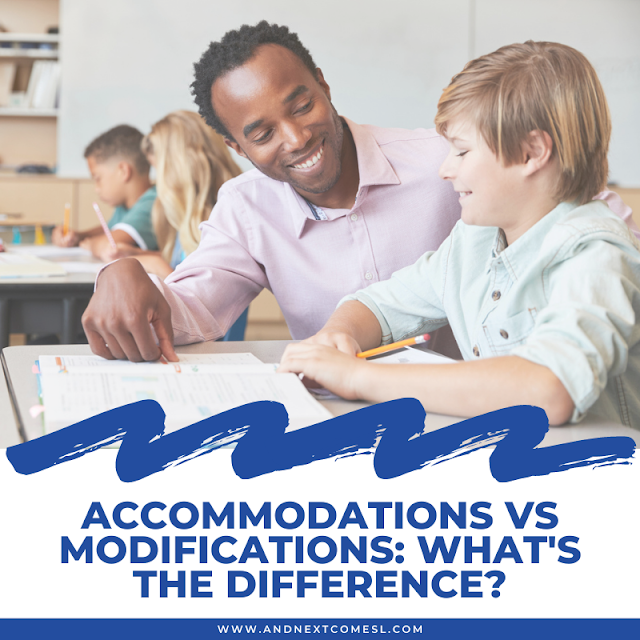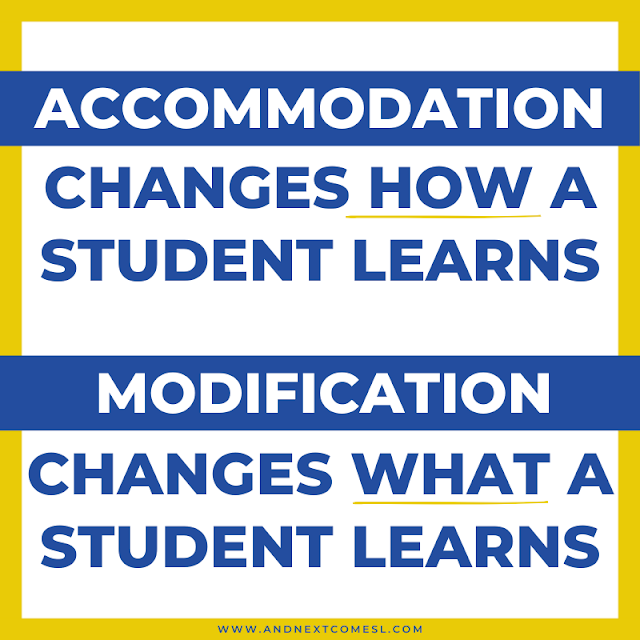Your autistic or hyperlexic child might qualify for something like an Individualized Education Program or Plan (IEP). But, depending on where you live, it might have a different name. And it might use a slightly different format. For instance, we have IIPs or Inclusion and Intervention Plans where I live.
Regardless of what the plan is called where you live, the goals remain similar. It's all about meeting the needs of a particular student. It's about making sure they receive the supports they need to be successful in the classroom. Doesn't matter if they're an elementary student, a middle grade student, or beyond.
You'll eventually meet with school staff for an IEP meeting about your child's educational program.
During these meetings, your child's general education teacher or special education teacher might use terms like accommodations and modifications. And you might be wondering what the difference between the two is.
While the two terms might seem similar, they are actually quite different. Both are meant to help optimize student performance. But they do so through different means. And learning the difference will help you be a better advocate for your child's needs.
So let's take a closer look at accommodations vs modifications.
Below you'll learn the difference between accommodations and modifications and what that means for your child's education. You'll also see some common examples of both.
Accommodations vs Modifications: What's the Difference?
There is one super easy way to remember the difference between accommodations and modifications. Accommodations are the how. Modifications are the what.
So an accommodation changes how the student learns the material. A modification, on the other hand, changes (aka modifies) what the student is taught or expected to learn.
But what do these mean in the context of a school setting for your child?
Well, let's dig a bit deeper into modifications vs accommodations, shall we?
What are Accommodations in Education?
Think of what the word accommodation means.
A quick google will give you a definition of "the process of adapting or adjusting to someone or something."
So, basically, an appropriate accommodation is all about adapting to or adjusting to the unique needs of an individual student.
It's important to remember that, with accommodations, the learning expectations do not change. That means that what the student is expected to learn stays the same as their peers. They still receive grade level instruction.
However, what does change is how the student learns the materials and curriculum. That might mean changing the environment or school setting. Accommodations might also mean delivering the materials in a different format. Or it might mean providing tools to help the child complete their assigned tasks.
Remember that it's all about adapting to the needs of the particular student here. Appropriate accommodations are designed to help kids meet academic expectations.
Some Common Examples of Appropriate Accommodations in the Classroom
Now that you know that accommodations are all about changing how the child or student learns, let's take a look at some examples.
Here are some simple changes or classroom accommodations that could be made:
- Providing more accessible educational materials (e.g., using larger font or print size, giving the child a written list of instructions to accompany verbal instructions)
- Allowing the child to take frequent breaks throughout the school day
- Giving a student extra time to complete assignments or tests
- Presenting the information in a different way or using a different format (e.g., listening to an audiobook instead of just relying on the printed text)
- Using sensory tools and fidgets that are tailored to the needs of the individual student
- Making changes to how assignments or tests are completed (e.g., responding to questions verbally instead of writing them down) and the setting in which they're completed (e.g., taking a test in a quieter space)
- Providing visual aids to help with assignments or other classroom activities (e.g., an outline of a lesson, graphic organizers, planners, etc.)
- Allowing the student to sit where and how they learn best within the classroom (e.g., using flexible seating, sitting closer to the teacher, etc.)
What are Modifications in Education?
Okay, now think of what the word modification means. It literally means changing something.
In this case, the changes are made to what a student is taught (aka the curriculum) or expected to learn.
So, with modifications, the learning expectations do change. Things are modified to meet the needs of the learner, meaning that what the child is expected to learn is different than their peers. As a result, expectations do not always stay at grade level.
The curriculum, materials, assignments, tests, and grading may all be altered. That means a student might be learning different things and/or doing different assignments than what other students complete.
Some Common Examples of Modifications in the Classroom
With modifications, remember that changes are made to the curriculum and to academic expectations. So what does that look like exactly?
Well, here are some example modifications that you might encounter:
- Assigning different homework assignments and/or using different test questions
- Allowing the child to learn different material than that taught to the rest of the general education classroom
- Excusing the child from certain projects or a particular test (and yes, this may include standardized tests)
- Using different educational standards or rubrics for grading and assessing assignments
A Quick Recap of Accommodations vs Modifications
Remember, accommodations change how students learn the material and modifications change what they learn.
It's also important to note that sometimes modifications and accommodations might be paired together in combination. For instance, your child might receive a modified test with different questions. But they might also receive testing accommodations such as dictating answers or having extra time to complete the test.
Getting a better understanding of the difference between accommodations vs modifications should help you be a better advocate for your child. So hopefully these examples and explanations were helpful.















